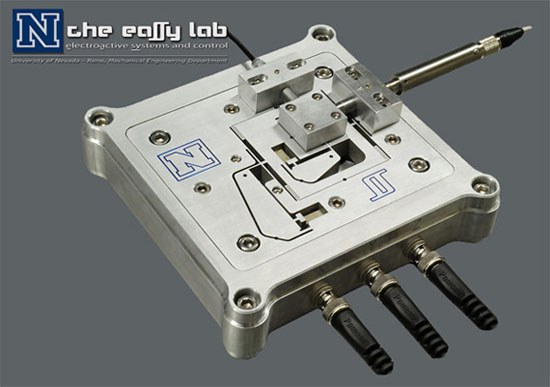Since 2007, we have been developing our own high-performance nanopositioning stages (nanopositioners) for research purposes. We specialize in serial-kinematic designs, and our nanopositioners have ranges up to 60 micrometers and dominant mechanical resonances as high as 150 kHz (unloaded). Photographs of our nanopositioners are shown below, in addition to related literature. If you are interested in obtaining a stage for research work, please contact Dr. Kam K. Leang for more info.
First Generation Design
Our first generation serial-kinematic two-axis nanopositioner design is shown below. This design incorporates modular simple beam flexures and parts that are assembled using fasteners as shown Fig. 1 below. As shown, the high-bandwidth x-axis is nested within the low-speed y-axis. The range is 10 um x 10 um, resonances are: x (29 kHz) and y (1.5 kHz).
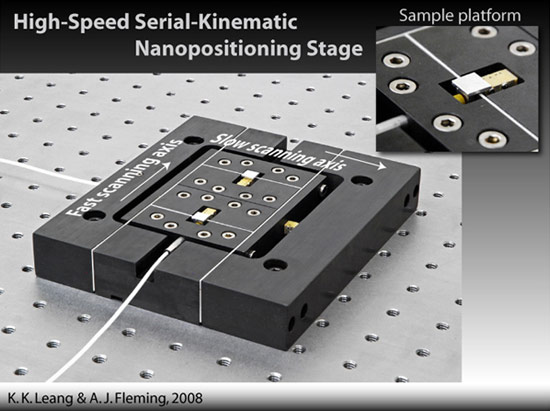
Figure 1. First generation serial-kinematic two-axis nanopositioner with inertial cancellation. Range: 10 um x 10 um; Resonances: 29 kHz (x) and 1.5 kHz (y). See reference Leang and Fleming (2009) below for more details about the design.
More details about this design can be found in the following reference:
“High-speed serial-kinematic AFM scanner: design and drive considerations”, K. K. Leang and A. J. Fleming Asian Journal of Control, Special issue on Advanced Control Methods for Scanning ProbeMicroscopy, Vol. 11, No. 2, pp. 144-153, 2009 [Click here to download manuscript in PDF].
Second Generation Design
Our second generation design is a monolithic design shown below in Fig. 2. In particular, the stage body is manufactured from 7075 aluminum using the wire electrical discharge machining (EDM) process to create a monolithic body. Compliant flexures are used to guide the motion of the sample stage along the x and y axes. Positioning of the sample in the vertical direction is achieved using a piezo-stack actuator embedded into the xpositioning stage. The dominant resonances in the x- and y-axes are measured at 10 and 2.4 kHz, respectively.
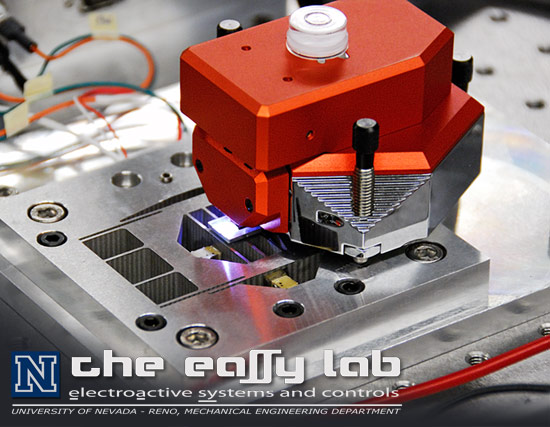
Figure 2. Generation 2 three-axis serial-kinematic nanopositioner, range is 10 um x 10 um x 3 um and the resonances are: 10 kHz (x), 2.4 kHz (y) and >40 kHz (z).
More details about this design can be found in the following reference:
“Integrated strain and force feedback for high performance control of piezoelectric actuators,” A. J. Fleming and K. K. Leang, Sensors & Actuators: A. Physical, Vol. 161, pp. 256-265, 2010. [ Click here to download PDF ]
Third Generation Design (high-speed nanopositioners)
Our third generation design is also monolithic, but the mechanical resonances were optimized for high-speed positioning. More specifically, the compliant flexures had improved vertical stiffness to minimize out-of-plane motion. The flexures were also strategically placed to minimize the sample platform’s tendency to rotate at high frequencies. There are two examples below shown in Fig. 3 and 4, where the design in Fig. 4 was used for high-speed AFM imaging at frame rates that exceeded 70 frames per second.
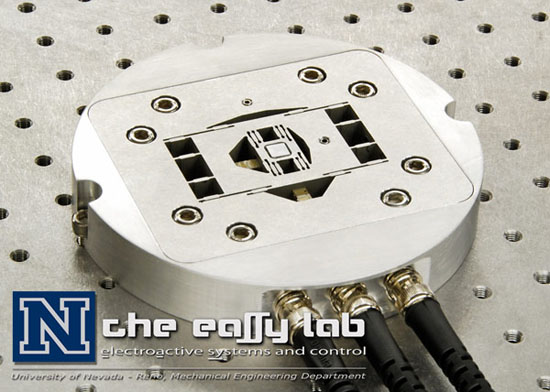
Figure 3. Three-axis serial-kinematic nanopositioner, with range of 10 um x 10 um x 2 um, resonance of 12 kHz (z), 5 kHz (y), and >50 kHz (z).
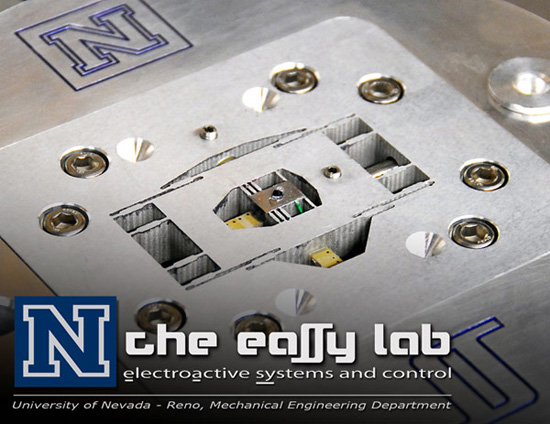
Figure 4. High-speed serial-kinematic nanopositioner. Range: 10 um x 10 um x 2 um, resonances: 24 kHz (z), 6 kHz (y), and >70 kHz (z).
More details about this design can be found in the following reference:
“Dual-Stage Repetitive Control with Prandtl-Ishlinskii Hysteresis Inversion for Piezo-Based Nanopositioning”, Y. Shan and K. K. Leang, Mechatronics, Special Issue on Mechatronic Systems for Micro- and Nanoscale Applications, Vol. 22, pp. 271 – 281, 2012. [ Click here to download PDF ]
“Design and control of a three-axis serial-kinematic high-bandwidth nanopositioner”, B. J. Kenton and K. K . Leang, IEEE/ASME Trans. on Mechatronics, Vol. 17, No. 2, pp. 356 – 369, 2012. [ Click here to download PDF ]
Long-Range Stages
The following are examples of our long-range, serial kinematic nanopositioners. These stages are designed such that their first dominant resonant mode is in the actuation direction. As such, the stage dynamics can be modeled by basic second-order transfer function models.
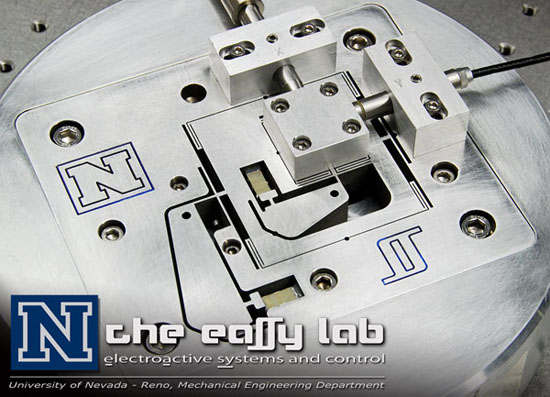
- Long range three-axis nanopositioner. Range: 40 um x 40 um x 3-10 um; Resonances: 700 Hz (x), 500 Hz (y) and >30 kHz (z).
Publications related to nanopositioners, nanopositioning, and piezoactuators:







